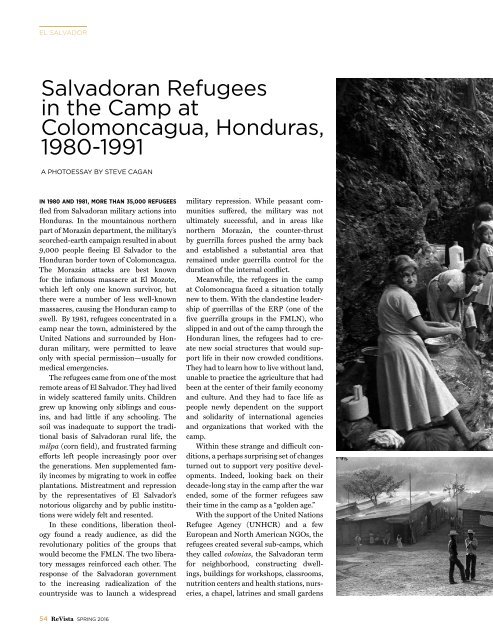EL SALVADOR
8clowSgZh
8clowSgZh
Create successful ePaper yourself
Turn your PDF publications into a flip-book with our unique Google optimized e-Paper software.
<strong>EL</strong> <strong>SALVADOR</strong><br />
Salvadoran Refugees<br />
in the Camp at<br />
Colomoncagua, Honduras,<br />
1980-1991<br />
A PHOTOESSAY BY STEVE CAGAN<br />
IN 1980 AND 1981, MORE THAN 35,000 REFUGEES<br />
fled from Salvadoran military actions into<br />
Honduras. In the mountainous northern<br />
part of Morazán department, the military’s<br />
scorched-earth campaign resulted in about<br />
9,000 people fleeing El Salvador to the<br />
Honduran border town of Colomoncagua.<br />
The Morazán attacks are best known<br />
for the infamous massacre at El Mozote,<br />
which left only one known survivor, but<br />
there were a number of less well-known<br />
massacres, causing the Honduran camp to<br />
swell. By 1981, refugees concentrated in a<br />
camp near the town, administered by the<br />
United Nations and surrounded by Honduran<br />
military, were permitted to leave<br />
only with special permission—usually for<br />
medical emergencies.<br />
The refugees came from one of the most<br />
remote areas of El Salvador. They had lived<br />
in widely scattered family units. Children<br />
grew up knowing only siblings and cousins,<br />
and had little if any schooling. The<br />
soil was inadequate to support the traditional<br />
basis of Salvadoran rural life, the<br />
milpa (corn field), and frustrated farming<br />
efforts left people increasingly poor over<br />
the generations. Men supplemented family<br />
incomes by migrating to work in coffee<br />
plantations. Mistreatment and repression<br />
by the representatives of El Salvador’s<br />
notorious oligarchy and by public institutions<br />
were widely felt and resented.<br />
In these conditions, liberation theology<br />
found a ready audience, as did the<br />
revolutionary politics of the groups that<br />
would become the FMLN. The two liberatory<br />
messages reinforced each other. The<br />
response of the Salvadoran government<br />
to the increasing radicalization of the<br />
countryside was to launch a widespread<br />
military repression. While peasant communities<br />
suffered, the military was not<br />
ultimately successful, and in areas like<br />
northern Morazán, the counter-thrust<br />
by guerrilla forces pushed the army back<br />
and established a substantial area that<br />
remained under guerrilla control for the<br />
duration of the internal conflict.<br />
Meanwhile, the refugees in the camp<br />
at Colomoncagua faced a situation totally<br />
new to them. With the clandestine leadership<br />
of guerrillas of the ERP (one of the<br />
five guerrilla groups in the FMLN), who<br />
slipped in and out of the camp through the<br />
Honduran lines, the refugees had to create<br />
new social structures that would support<br />
life in their now crowded conditions.<br />
They had to learn how to live without land,<br />
unable to practice the agriculture that had<br />
been at the center of their family economy<br />
and culture. And they had to face life as<br />
people newly dependent on the support<br />
and solidarity of international agencies<br />
and organizations that worked with the<br />
camp.<br />
Within these strange and difficult conditions,<br />
a perhaps surprising set of changes<br />
turned out to support very positive developments.<br />
Indeed, looking back on their<br />
decade-long stay in the camp after the war<br />
ended, some of the former refugees saw<br />
their time in the camp as a “golden age.”<br />
With the support of the United Nations<br />
Refugee Agency (UNHCR) and a few<br />
European and North American NGOs, the<br />
refugees created several sub-camps, which<br />
they called colonias, the Salvadoran term<br />
for neighborhood, constructing dwellings,<br />
buildings for workshops, classrooms,<br />
nutrition centers and health stations, nurseries,<br />
a chapel, latrines and small gardens<br />
54 ReVista SPRING 2016


